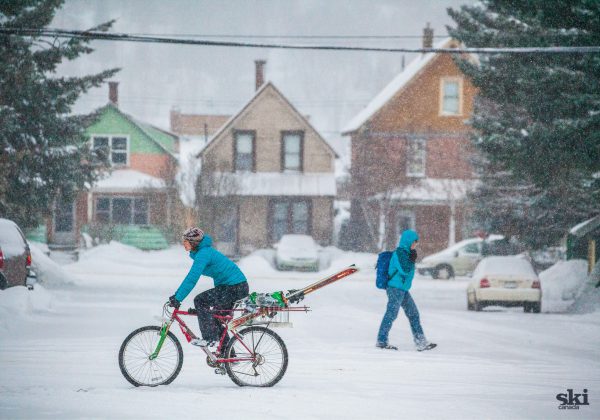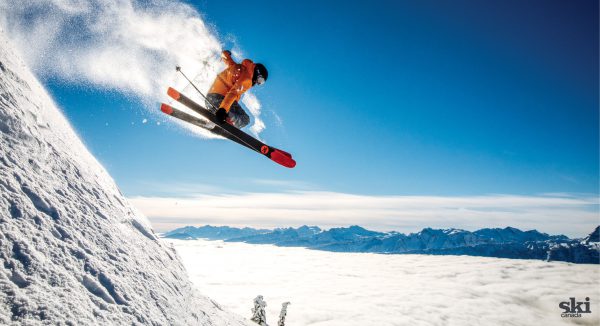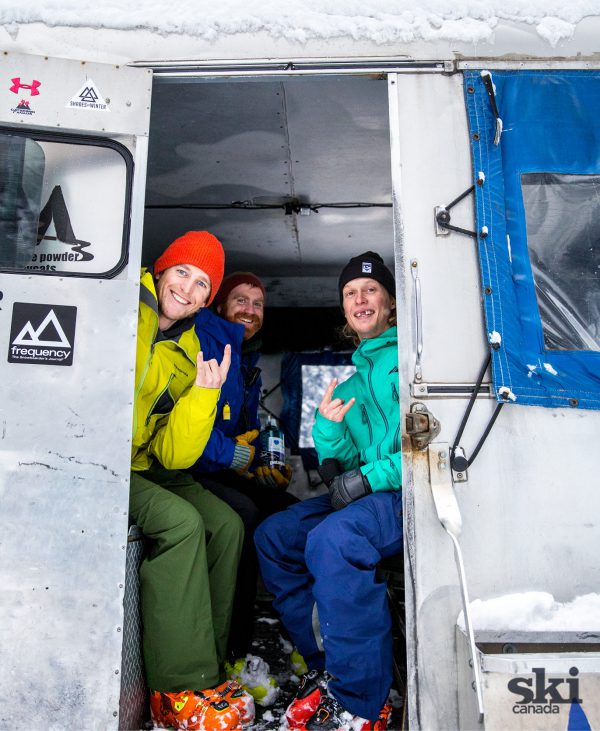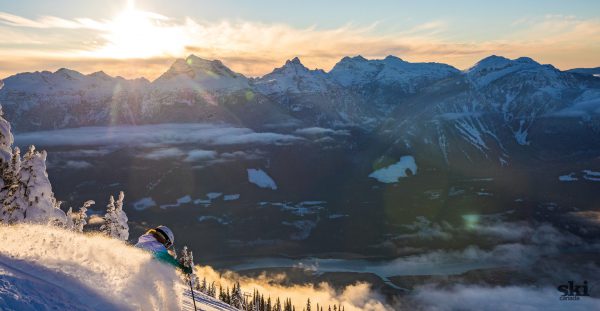How one small-town reporter learned to love Revelstoke.
It was the perfect welcome to a new mountain: 25 cm of new snow. A blank canvas crumpled up, its nooks and crannies waiting to be painted, mysteries around every bend. This is how legends are built, addiction is bred.
I moved to Revelstoke from Toronto in mid-September 2009 after being hired to work at the local weekly newspaper, at the time called the Revelstoke Times Review. After two weeks of sunny weather, the switch flipped and for the next two months it rained every day, or so I remember. Revelstoke, tucked into the beautiful Columbia River Valley between the Selkirk and Monashee Mountains, can feel claustrophobic at the best of times. When it rains like it did that autumn, combined with even shorter days as daylight falls behind the peaks in the middle of the afternoon, one starts to question life choices.

Revelstoke Mountain Resort (RMR) was the reason I moved there. I knew nothing of the town except it had a young ski resort that was being hyped as the “next Whistler.” With its biggest vertical drop in North America, development plans included 20 lifts and 4,000 hectares of terrain at build-out. Before arriving, I’d also heard boasts of 40 to 60m of snow each winter, an oft-repeated claim that always bothered me because although Revelstoke beats most others in snowfall, 40 to 60m simply wasn’t true. But I’d skied my whole life, and decided if I was going to slum it as a small-town reporter, I just needed a destination where I could ski at the same time.
I arrived in a community in transition, one that was dealing with its evolution into a resort town at the same time as the Great Recession. A housing boom, sparked by the birth of RMR, was already over, but few had yet realized it. A steady influx of newcomers was moving to town from across Canada and beyond, lured by the legends of bottomless powder and vast terrain.
The resort had opened just before Christmas 2007. I arrived two years later—after it had been rescued from bankruptcy. There was one gondola and two detachable quads, and a hotel under construction. The rest of the ambitious master plan was already on hold.
I remember my first day as a blur. The hill opened a week early because there was so much early-season snow (a benefit of all that rain in the valley), with not even much of a lift line. I met a co-worker, who introduced me to his friends, and they showed me around, leading me into the vast bowls and through gaps in trees separating one stash from another. The mountain was an unknown and cliff signs were sporadic. The snow and terrain exceeded anything I’d ever experienced.

At some point, I joined up with Chris Rubens, a pro skier, whom I was writing an article about, and his crew that included former Olympian Christina Lusti, pros Dan Treadway and possibly Eric Hjorleifson—as I mentioned, looking back it’s all a bit blurry now. I chased them through North Bowl, desperate to keep up as I hurtled toward rollovers that could have been cliffs for all I knew. I grew up in Quebec skiing at Owl’s Head, and I was used to eastern hardpack. I could ski powder but here, I was in over my head, sometimes literally. At one point I lost it in front of the gang while they were stopped and waiting. Not for me, though—as I dusted myself off, Treadway came soaring off a 10m cliff and stomped the landing. If you’ve read an article boasting about Revelstoke’s endless powder, rugged and tough terrain—and its empty slopes—you were reading about days like that.
Revelstoke was a great place to write about, with lots of issues surrounding development, plenty of colourful characters and passionate locals. It was a real community with history dating back to the 1880s when the Last Spike was hammered home nearby, completing Canada’s first national railway. Forestry and the railway were the drivers of the local economy, but tourism was up-and-coming.
It was a community with a ski resort, the opposite of somewhere like purpose-built Whistler, where the village was an appendage to the resort. For many locals, RMR could disappear and it wouldn’t make a lick of a difference. They were already immersed in winter; the ski club was almost a century old and the snowmobile club had been around since the ’60s. Volunteerism was ingrained in the community—and still is. It was a place where residents worked together to find local solutions to local problems. I loved socializing at the farmers’ market, watching Junior B hockey and taking in history talks by Cathy English, the delightful curator of the town museum.
Of course, it wasn’t all great. Having just left Toronto, Revy’s choice of restaurants was pretty dismal, and the nightlife was lacking. We’d start the night at the Last Drop, continue on to the Regent, and if desperate enough, ended up at Outtabounds (aka “Outta-options”) which is now outta-business. When you weren’t skiing, the weather from October to March was grim. The Trans-Canada Highway during challenging weather made it hard to get away.
Living in a ski town is living the dream, if you can find a decent job—and a place to live. “My life is your vacation” was a mantra we would brag obnoxiously—or perhaps defensively. My friends, mostly eastern transplants, were almost all new to town and worked classic ski town jobs as servers, line chefs, liftees, tree planters and patrollers.

Many of my early friends moved on while others persevered and became business owners, managers, Realtors and local politicians. The guy who ran the hot dog stand went on to start a community radio station, then a property management company, before reaching self-actualization as a city councillor. A German friend who was trained as an architect started as a liftee and worked at a small mill before finally finding work in his field and starting his own firm. Two other friends, one local and the other from Oshawa, Ontario, joined forces to start a food truck that turned into the successful Taco Club restaurant. Joe Lammers, former Whistlerite and host of Ski Television, is now a local Realtor.
Me? I didn’t intend to stay, but skiing became the priority—and the summers were incredible. Winter work revolved around powder days. I’d never seen as much snow as I did my second winter here, when the snowbanks turned the streets into tunnels and every day was a powder day. I skied as much as possible, exploring every nook and cranny inbounds. Hike the Lemming Line, drop into North Bowl, scooch into Three Bears, drop through the chutes into the Carwash, traverse to Monkey Bars and exit to the Ripper Chair via Ron Burgundy’s. Most of those names aren’t on the trail map, but they’re still some of the best parts of the mountain.
In 2014, I was appointed editor of the town paper and, in the nick of time, I bought a home. The following year, the economy began to boom again. Development proposals flowed into city hall and tourism took off. The crowds grew in town and at the resort. Instead of fighting them, I joined the growing numbers exploring the truly epic backcountry.
When I moved to Revelstoke, I didn’t know ski touring was a thing; within a few years, I was fully immersed in the town’s backcountry culture, trying to learn as much about avalanches as I could, often by writing about them. A few months into the job, I wrote a story of four snowmobilers who barely survived a slide just outside of town. When I called the head of Search and Rescue and asked if avalanches were normal so early in the season, he chuckled. “You must be new here! If it’s deep enough to ride, it’s deep enough to slide.”
A few months later, nursing a brutal hangover from my 30th birthday, I reported on the nearby Boulder Mountain avalanche, where a three-day snowmobiling event turned tragic and two people died and many injured. Considering there were more than 100 people caught up in that incident, it’s a miracle it wasn’t worse.
Revelstoke, as home to Avalanche Canada and countless ski guides, has a strong backcountry safety culture. Everyone toured (and/or snowmobiled), or said they wanted to get into it. My first move was to take an Avalanche Skills Training course. I went out twice with a friend who was training to be a guide; I nearly died from exhaustion, but I was intrigued. Touring was a way to extend my ski season, and that was good enough for me. I read about the exploits of the locals—pioneers like the McCrae brothers and living legends like Ruedi Beglinger and Greg “2 Mill” Hill. Revelstoke attracted a breed of freeriders that pushed farther and farther into the backcountry to find new lines to ski and I couldn’t help but be inspired.
It took a few years until I felt comfortable in the backcountry. It’s a wicked learning environment where you don’t know if you’re good or just lucky. Avalanches became my obsession and if I had a beat at the paper, that was it. They fascinated me personally and professionally; when the local tow-truck operator asks if you want to watch him pull a truck out of an avalanche, you say yes right away.

RMR turned 12 in 2019 and it finally seems ready to enter into a new phase of growth. A long-planned beginner chair will open on the upper mountain this winter, providing learning terrain up high. The updated master plan calls for a new chairlift in North Bowl, and another that will extend the boundary beyond South Bowl. There’s a new slopeside hotel being built, and a bike park opened last summer. Beyond the resort, numerous developers are looking to profit from Revelstoke’s notoriety, though a recent proposal to build a luxury chalet on our iconic Mount Begbie was loudly shouted down.
Revelstoke’s problems are born from success. There’s a housing crisis because too many people want to live here. Like at so many towns near ski resorts, some long-time locals lament the shifts in the community they worked hard to build, complaining greed has taken over, though many newcomers are working hard to expand on their foundation. Earlier this year, a wide cross-section of the community formed Vibrant Revelstoke as part of efforts to address housing and many other issues.
I was asked to provide some advice about moving to Revelstoke. There’s a lot I could say about this, but the reason I fell in love with Revelstoke is not just because of the snow, it’s because of a community with a long, proud history. It existed long before the resort and would still be an idyllic mountain town without it.
Love the mountains, live your dream—but make sure you also give back.
Alex Cooper is now Communications Assistant at Avalanche Canada in Revelstoke.